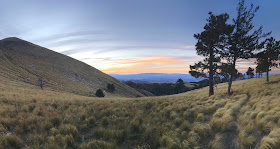To be honest I didn’t research this area much before I went. The book “
Day Hikes and Nature Walks of the Las Cruses Area” called Three Rivers Trail the “prettiest canyons in New Mexico” and “alpine meadows” which was enough.
 |
| My parents drop me off at the trailhead at Three Rivers Campground. It's the second week of winter vacation. Last night Dad went to bed at 7 PM after our hike together. I sense they might welcome a break from hiking with me. |
A google search (after the fact) doesn't reveal much about the White Mountain Wilderness of New Mexico anyway. The White Mountains of New Hampshire pop up. Also the White Mountains Wilderness of California. So when I started up the Three Rivers Trail, I didn't have any preconceived notions of what I would find or what it would look like.
 |
| I certainly didn't expect all this water. |
Having no expectations is a good tactic for happiness. On trails and in life. It makes it feel like stumbling upon beauty and discovering everything for yourself. Wonder is heightened when you don’t know what the view will be like when you first peer over the saddle for the first time, or when your feet meet a soft carpet of pine needles and you didn’t even know there would be pine up here.
 |
| The rock formations and waterfalls are impressive, but not TOO dramatic. Not enough to draw crowds. At least not in the middle of winter. |
But I’d rather have a quiet, wild-feeling place than the crowds standing in line to take instagram-worthy, trending hashtag selfies anyway.
The most amazing parts of this place cannot be captured in photos. The gurgling sound of the desert stream plunging over boulders. The frenzied chirping of songbirds and the chortling of wild turkeys before they take off in a flash.
 |
| Birds, like this hairy woodpecker, around every corner. |
Massive trees line the canyon and I spend a lot of time standing around gawking, looking upward. The first aspen I come to towers gracefully overhead and I pull out my camera.
Out of the corner of my eye, a flash. I spin around and duck at the same time.
 |
| Golden eagle. |
All the thoughts stream through my brain at once. Lightening fast reptilian brain impulses. It's coming for me! It’s going to carry me off with those razor sharp talons! Small mammalian ancestors have thought these very thoughts.
I imagine I can feel the rush of air as it soars over my head. It is an experience I know I will remember for the rest of my life. The definition of wild.
Only miles up the trail do I wonder, what was it doing near the stream? Was there a carcass? Why did it fly so close to me?
 |
| Snowy north-facing slopes. But thankfully this trail sticks to the sunny side as it switchbacks up to the saddle. |
I was so pumped on my fight or flight response up I didn’t even realize that I fly by the last water source. Will I regret going past the perfectly good, sheltered (and warmer!) campsites to go high to camp at the crest of the mountains? It is the end of December, after all!
 |
| After cresting the saddle near White Horse Hill. |
There is sunset beauty in all directions. No regrets! I dash around and gaze in wonder. The white gypsum sands of White Sands National Monument reflecting the pink glow of the sunset.
 |
| More changing colors. |
Oh why didn't I find a campsite before it got so
dark? But I do find a spot in in the shelter of large trees, with views
all around. The wind howls for a bit, but it's not as cold as it could
be. And I am snug.
 |
| The next morning, I follow the Crest Trail southward. No, not THAT Crest Trail. |
I climb up and over the rise of a hill, there are large figures covering the far slope.
 |
| Elk. |
They hear me and start moving in a massive wave. I'm in a nature documentary. I feel bad to have disturbed them but I'm glad they are skittish because, honestly, I'm scared of them.
 |
| Along the Crest Trail. |
 |
| Long switchbacks down to Bonita Spring, which is dry. I'm glad I got water at the piped spring at the base of Elk Point. |
 |
| Dropping off the crest, down the Dry Canyon Trail. |
 |
| Blow-downs are plentiful and the trail is hard to follow. But I enjoy route-finding and know I just need to get down the slope and follow the canyon. |
Dry Canyon surprises me by having a spring and flowing water. More birds
and big trees. Around another corner, in dense oak and pine, another
sight. A carcass of an elk. Massive. How did it die? Did it get away
from a hunter? Fall prey to a mountain lion? I move away as quickly just
in case the later is true.
 |
| Elk. |
This place just seems so wild. Full of life and death and a richness that is hard to describe.
Back at the trailhead, my parents meet me just as I walk into the parking lot. They always seem to know when to arrive.
"Next year, do you want to spend a week up there?" my dad asks.
"Absolutely!" I reply.
More Information
"
Day Hikes and Nature Walks in the Las Cruces - El Paso Area" by Greg Magee
Three Rivers Trail
Crest Trail - information and trail status in a
pdf



















































